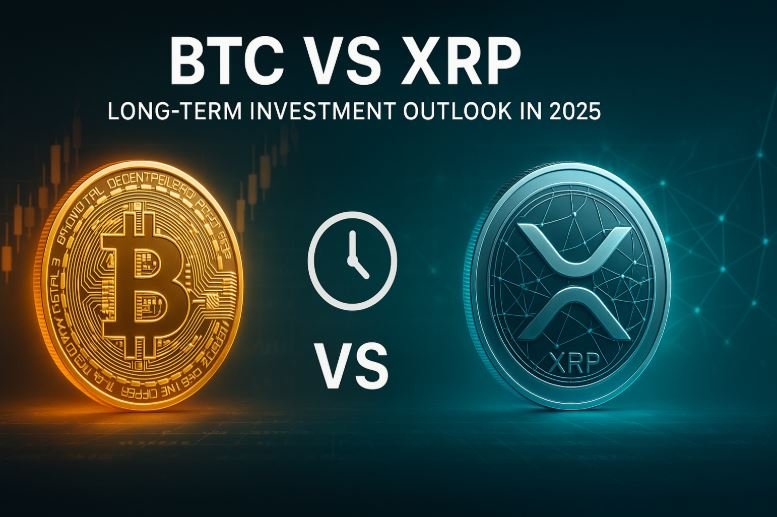As 2025 begins, the cryptocurrency market continues to mature, drawing greater attention from both retail and institutional investors. The spotlight often falls on two digital assets that represent contrasting narratives: Bitcoin (BTC), widely regarded as digital gold, and XRP, designed to streamline global payments. For long-term holders, the decision between BTC and XRP is not simply about chasing short-term gains, but about understanding their unique functions, risk profiles, and future prospects.
This article provides an in-depth comparison of BTC and XRP from an investment outlook perspective in 2025, exploring their market conditions, regulatory environments, adoption levels, and potential trajectories. The goal is to equip readers with a clearer understanding of each asset’s strengths and challenges while acknowledging that cryptocurrencies remain volatile and speculative.

Bitcoin in 2025: The Case for Digital Gold
Store of Value Narrative
Since its launch in 2009, Bitcoin has positioned itself as a decentralized, censorship-resistant asset with a hard supply cap of 21 million coins. This scarcity model supports the idea that BTC functions as a hedge against inflation and government monetary policy. In an era where traditional fiat currencies face persistent devaluation pressures, Bitcoin continues to attract investors who value its independence and predictability.
Institutional Adoption
Institutional participation in Bitcoin has expanded significantly over the past two years. Spot Bitcoin ETFs, approved in the United States in early 2024, now account for more than $120 billion in assets under management. These vehicles offer traditional investors an easier way to gain exposure to Bitcoin without dealing with the complexities of self-custody. As a result, Bitcoin has become deeply integrated into the global financial system.
This trend has also been reinforced by mainstream adoption indicators. For example, the Bitcoin price has remained a key metric followed by asset managers, banks, and policymakers alike. The heightened visibility has cemented Bitcoin’s reputation as a long-term store of value.
Government and Policy Perspectives
The U.S. government has signaled a more balanced stance toward Bitcoin regulation. While there is continued oversight from the SEC and CFTC, discussions around potentially treating Bitcoin as a strategic reserve asset demonstrate growing institutional confidence. This aligns with moves by countries such as El Salvador that have integrated Bitcoin into their national financial strategies.
Growth Projections
Forecasts from research firms like ARK Invest remain extremely bullish, with some predicting Bitcoin could approach $939,000 by 2030 if adoption trends continue. While such estimates are speculative, they highlight the market’s belief in Bitcoin’s long-term resilience.
Key takeaway: Bitcoin’s long-term narrative remains strong, built on its scarcity, institutional adoption, and increasing alignment with government policies.
XRP in 2025: Utility and Growth Potential
Purpose and Use Case
XRP, launched by Ripple in 2012, was built to serve as a bridge asset for cross-border transactions. Unlike Bitcoin’s focus on value storage, XRP emphasizes utility, offering near-instant settlement times and minimal fees. This efficiency has attracted financial institutions seeking alternatives to outdated systems like SWIFT.
Regulatory Progress
XRP’s journey has been complicated by its legal battle with the U.S. Securities and Exchange Commission (SEC). While Ripple achieved partial clarity in 2023 when a U.S. court ruled that XRP is not always a security, the matter is not fully resolved. Ongoing appeals leave regulatory uncertainty hanging over XRP’s future, though a shift in the political landscape under the new U.S. administration in 2025 could create a more favorable environment for Ripple and other payment-focused cryptocurrencies.
Price Projections and Investment Example
Analysts remain divided on XRP’s future trajectory. Some forecasts suggest that by 2030, the token could trade between $12 and $20, representing significant upside from its current levels. A $1,000 investment today could potentially grow into $4,000 to $7,000 over the next five years if adoption and regulatory conditions improve.
For everyday investors, tracking the XRP price has become increasingly important, particularly given its sensitivity to legal and regulatory announcements. Unlike Bitcoin, XRP’s valuation is tightly linked to its progress in financial partnerships and legal clarity.
Market Adoption
Ripple continues to secure partnerships with banks and payment providers worldwide. These integrations, though not without challenges, point toward a future where XRP could play a central role in international finance if regulatory clarity is achieved.
Key takeaway: XRP presents higher risk compared to Bitcoin, but it also carries higher potential reward due to its utility-driven growth model.
Key Differences Between BTC and XRP
Purpose
- Bitcoin: Primarily a store of value, viewed as digital gold.
- XRP: Designed for real-time settlement of cross-border payments.
Adoption
- Bitcoin: Widely accepted by institutions, integrated into ETFs and recognized globally.
- XRP: Adoption concentrated among banks and payment processors.
Risk Profile
- Bitcoin: Lower relative risk, though still volatile. Supported by strong infrastructure and legal recognition.
- XRP: Higher risk due to regulatory uncertainty, though it has strong utility potential.
Trust and Liquidity
- Bitcoin: Established global recognition and liquidity.
- XRP: Faces lingering skepticism tied to ongoing SEC litigation.
Investment Outlook for Long-Term Holders
Bitcoin Outlook
For conservative long-term holders, Bitcoin represents a reliable foundation. Its supply cap, institutional integration, and recognition as a non-security asset position it as one of the most resilient digital assets. While it will still experience volatility, the broader trend points toward gradual appreciation over time.
XRP Outlook
XRP is a more speculative asset. If Ripple successfully navigates its legal hurdles and financial institutions continue adopting its network, XRP’s price could appreciate significantly. However, the risks are higher, particularly if regulatory decisions turn unfavorable or if adoption stalls.
Portfolio Strategy
Long-term investors often benefit from diversification. A strategy that allocates Bitcoin as a core holding, with XRP as a smaller speculative position, can balance stability with exposure to growth opportunities. This approach allows investors to capture the upside of XRP’s utility-driven narrative while leaning on Bitcoin’s more established role in the market.
Risk reminder: Cryptocurrencies remain volatile assets. Prices can fluctuate dramatically due to market sentiment, regulatory announcements, or macroeconomic changes. Investors should only commit capital they can afford to lose and should conduct their own due diligence.
Conclusion
As 2025 unfolds, the choice between Bitcoin and XRP depends largely on an investor’s objectives and risk tolerance. Bitcoin remains the safer, more established option, supported by institutional adoption and its growing role as a hedge against inflation. XRP, by contrast, offers a utility-driven investment case with the potential for outsized returns, but carries higher regulatory and adoption risks.
For long-term holders, Bitcoin is best positioned as the foundation of a cryptocurrency portfolio, while XRP serves as a speculative complement. The combination allows investors to benefit from both the stability of digital gold and the innovation of cross-border financial technology.
Ultimately, neither asset is inherently better for all investors. Success in crypto investing depends on informed decision-making, realistic expectations, and an understanding that the market remains both dynamic and uncertain.
Disclaimer: This article is for educational purposes only and should not be taken as investment advice. Cryptocurrency investments are speculative and involve significant risk. Readers should consult financial professionals before making any investment decisions.
